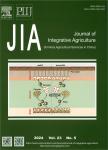MicroRNA-22 inhibits proliferation and promotes differentiation of satellite cells in porcine skeletal muscle
MicroRNA-22 inhibits proliferation and promotes differentiation of satellite cells in porcine skeletal muscle作者机构:National Engineering Research Center for Breeding Swine Industry/Guangdong Provincial Key Laboratory of Agro-Animal Genomics and Molecular Breeding/College of Animal ScienceSouth China Agricultural UniversityGuangzhou 510642P.R.China Bac Giang Agricultural and Forestry UniversityBac Giang 26000Viet Nam Department of Human NutritionFood and Animal SciencesCollege of Tropical Agriculture and Human ResourcesUniversity of Hawaii at ManoaHonoluluHI 96822USA
出 版 物:《Journal of Integrative Agriculture》 (农业科学学报(英文版))
年 卷 期:2020年第19卷第1期
页 面:225-233页
核心收录:
基 金:supported by the Key Foundation for Basic and Application Research in Higher Education of guangdong, China (2017KZDXM009) the China Postdoctoral Science Foundation (2018M640789) the Provincial Agricultural Science Innovation and Promotion Project, China. (2018LM2150)
主 题:miR-22 skeletal muscle porcine satellite cells proliferation differentiation
摘 要:Pig is an important economic animal in China. Improving meat quality and meat productivity is a long time issue in animal genetic breeding. Micro RNAs(mi RNAs) are short non-coding RNAs that participate in various biological processes, such as muscle development and embryogenesis. mi R-22 differentially expresses in embryonic and adult skeletal muscle. However, the underlying mechanism is unclear. In this study, we investigated mi R-22 function in proliferation and differentiation of porcine satellite cells(PSCs) in skeletal muscle. Our data show that mi R-22 expressed in both proliferation and differentiated PSCs and is significantly upregulated(P0.05) during differentiation. After treated with the mi R-22 inhibitor, PSCs proliferation was significantly increased(P0.05), as indicated by the up-regulation(P0.01) of cyclin D1(CCND1), cyclin B1(CCNB1) and down-regulation(P0.05) of P21. Conversely, over-expression of mi R-22 resulted in opposite results. Differentiation of PSCs was significantly suppressed(P0.05), evidenced by two major myogenic markers: myogenin(Myo G) and myosin heavy chain(My HC), after transfecting the PSCs with mi R-22 inhibitor. Opposite results were demonstrated in the other way around by transfection with mi R-22 mimics. In conclusion, the data from this study indicated that mi R-22 inhibited the PSCs proliferation but promoted their differentiation.



